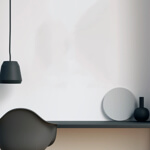Geoffrey Clarke 1924-2014
Head, 1952
Iron
61 x 16 x 28 cms
24 1/16 x 6 4/16 x 11 1/16 ins
24 1/16 x 6 4/16 x 11 1/16 ins
526
Sold
The pared-down linear nature of Head reveals Geoffrey Clarke's interest in tribal art during the early 1950s. The artist's time spent in the British Museum studying tribal objects and this...
The pared-down linear nature of Head reveals Geoffrey Clarke's interest in tribal art during the early 1950s. The artist's time spent in the British Museum studying tribal objects and this complemented the influence of Picasso's simplified iron sculpture on Clarke's work at this time. These two artists are further associated through their shared technique of forged and welded iron.
The powerful directness of Head lies in the elongated figure's frontal gaze. The spherical eyes and pyramidal nose protrude from the upper face below which an open mouth juts out at the end of a tube emanating from the central spine of the figure. This important work illustrates Clarke's success in representing Man as an organic, abstracted form.
The powerful directness of Head lies in the elongated figure's frontal gaze. The spherical eyes and pyramidal nose protrude from the upper face below which an open mouth juts out at the end of a tube emanating from the central spine of the figure. This important work illustrates Clarke's success in representing Man as an organic, abstracted form.
Exhibitions
Henry Moore and the Geometry of Fear, James Hyman Gallery, 19 November 2002 - 18 January 2003, (cat. 10)Literature
Henry Moore and the Geometry of Fear, James Hyman Gallery, London, 2002, (cat. 10), detail p.24 and illustrated p.26.Join our mailing list
* denotes required fields
We will process the personal data you have supplied to communicate with you in accordance with our Privacy Policy. You can unsubscribe or change your preferences at any time by clicking the link in our emails.




